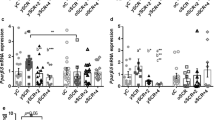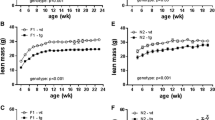Abstract
The effect of dietary protein content on the uncoupling proteins (UCP) 1, 2 and 3 expression in a number of tissues of Zucker lean and obese rats was studied. Thirty-day-old male Zucker lean (Fa/?) and obese (fa/fa) rats were fed on hyperproteic (HP, 30% protein), standard (RD, 17% protein) or hypoproteic (LP, 9% protein) dietsad libitum for 30 days. Although dietary protein intake affected the weights of individual muscles in lean and obese animals, these weights were similar. In contrast, huge differences were observed in brown adipose tissue (BAT) and liver weights. Lean rats fed on the LP diet generally increased UCP expression, whereas the HP group had lower values. Obese animals, HP and LP groups showed higher UCP expression in muscles, with slight differences in BAT and lower values for UCP3 in subcutaneous adipose tissue. The mean values of UCP expression in BAT of obese rats were lower than in their lean counterpart, whereas the expression in skeletal muscle was increased. Thus, expression of UCPs can be modified by dietary protein content, in lean and obese rats. A possible thermogenic function of UCP3 in muscle and WAT in obese rats must be taken into account.
Resumen
Se determina el efecto de cambios moderados en el contenido proteico de la dieta sobre la expresión de las proteínas desacoplantes 1, 2 y 3 en distintos tejidos de la rata Zucker. A ratas Zucker macho de 30 días de edad, tanto delgadas (Fa/?) como obesas (fa/fa), se les administraad libitum una dieta hiperproteica (HP, 30% de contenido proteico), estándar (RD, 17% de contenido proteico) o hipoproteica (LP, 9% de contenido proteico) durante 30 días. Los pesos de los músculos individuales son similares en los animales delgados y en los obesos, aunque ligeramente influenciados por el tipo de dieta; este hecho contrasta con las grandes diferencias detectadas en el hígado y en el tejido adiposo marrón. Los animales delgados alimentados con dieta LP incrementan la expresión de las UCP, mientras que los alimentados como dieta HP muestran valores más bajos. Los animales obesos, tanto los alimentados con dieta LP como con dieta HP, muestran una mayor expresión de UCP en músculo, con pequeñas diferencias en el tejido adiposo marrón y valores muy bajos para la UCP3 en el tejido adiposo subcutáneo. Los valores promedio de la expresión de UCP en el tejido adiposo marrón de las ratas obesas son menores de los de las ratas delgadas, mientras que la expresión en los músculos es superior. Así, la expresión de las UCP puede ser modificada por la ingesta crónica de dietas con dstinto contenido proteico, tanto en ratas delgadas como obesas. Se debe considerar el posible papel termogénico de la UCP3 en el músculo y en el tejido adiposo blanco de las ratas obesas.
Similar content being viewed by others
References
Boss, O., Samec, S., Kühne, F.et al. (1998):J. Biol. Chem.,273, 5–8.
Chan, C. P., Hansen, R. J. and Stern, J. S. (1985):J. Nutr.,115, 959–969.
Clapham, J. C., Arch, J. R. S., Chapman, H.,et al. (2000):Nature,406, 415–418.
Didier, R., Rémésy, C., Demigné, C. and Fafournoux, P. (1985):Nutr. Res.,5, 1093–1102.
Dunn, M. A. and Hartsook, E. W. (1980):J. Nutr.,110, 1865–1879.
Durschlag, R. P. and Layman, D. K. (1983):Growth,47, 282–291.
Echtay, K. S., Winkler, E., Frischmuth, K. and Klingenberg, M. (2001):Proc. Natl. Acad. Sci. U.S.A.,98, 1416–1421.
Esteve, M., Rafecas, I., Remesar, X. and Alemany, M. (1992):Int. J. Obes.,16, 237–244.
Fleury, C., Neverova, M., Collins, S.et al. (1997):Nature Genet.,15, 2269–2272.
Godbole, V., York, D. A. and Bloxham, D. P. (1978):Diabetologia,15, 41–44.
Harper, J. A., Stuart, J. A., Jekabsons, M. B.,et al. (2002):Biochem. J.,361, 49–56.
Hidaka, S., Kakuma, T., Yoshimatsu, H.,et al. (1998):Biochim. Biophys. Acta,1389, 178–186.
Himms-Hagen, J. and Harper, M. E. (1999):Int. J. Obesity,23, S30-S32.
Langin, D., Larrouy, D., Barbe, P.et al. (1999):Int. J. Obesity,23, S64-S67.
Lanza-Jacoby, S. and Kaplan, M. L. (1984):Int. J. Obesity,8, 451–456.
Masanés, R., Rafecas, I. and Remesar, X. (1999):J. Nutr. Biochem.,10, 716–722.
Masanés, R., Fernández-López, J. A., Alemany, M.et al. (1999):Nutr. Res.,19, 1017–1026.
Matsuda, J., Hosoda, K., Itoh, H.,et al. (1997):FEBS Lett.,418, 200–204.
Meyers, J. H. and Hargus, W. A. (1959):Am. J. Physiol.,17, 1350–1352.
Peret, J., Bach, A. C., Delhomme, B.,et al. (1984):Metabolism,33, 200–207.
Peters, J. C. and Harper, A. E. (1984):Physiol. Behav.,33, 783–790.
Radcliffe, J. D. and Webster, A. J. F. (1978):Br. J. Nutr.,39, 483–492.
Savontaus, E., Rouru, J., Boss, O.,et al. (1998):Biochem. Biophys. Res. Commun.,246, 899–904.
Silva, J. E. (1999):Int. J. Obesity,23, S72-S64.
Swick, R. W. and Gribskov, C. L. (1983):J. Nutr.,113, 2289–2294.
Tawa, N. E. and Goldberg, A. L. (1992):Am. J. Physiol.,263, E317-E325.
Tulp, O., Krupp, P. P., Danforth, E. and Horton, E. S. (1979):J. Nutr.,109, 1321–1332.
Weigle, D. S., Selfridge, L. E., Schwartz, M. W.,et al. (1998):Diabetes,47, 298–302.
Yamashita, T., Murakami, T., Iida, M.,et al. (1997):Diabetes,46, 1077–1080.
Author information
Authors and Affiliations
Corresponding author
Rights and permissions
About this article
Cite this article
Masanés, R.M., Yubero, P., Rafecas, I. et al. Changes in UCP expression in tissues of Zucker rats fed diets with different protein content. J. Physiol. Biochem. 58, 135–141 (2002). https://doi.org/10.1007/BF03179850
Received:
Issue Date:
DOI: https://doi.org/10.1007/BF03179850




